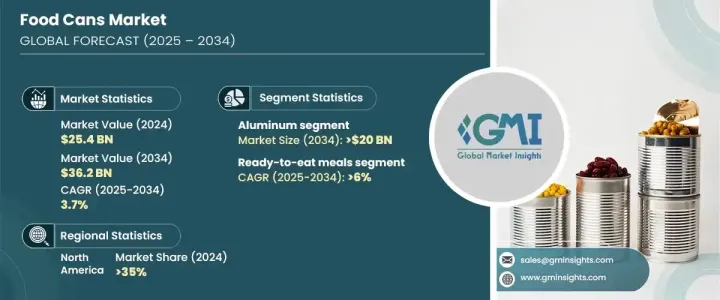
세계의 식품 캔 시장은 2024년에 254억 달러로 평가되었고, 2025년부터 2034년까지 연평균 복합 성장률(CAGR) 3.7%로 안정적인 성장을 이룰 것으로 예측됩니다.
이러한 증가 추세는 주로 편의성과 장기 보존의 이점을 모두 제공하는 보존 안정성이 높은 패키징 솔루션에 대한 수요가 증가함에 기인합니다. 식품 캔은 내구성, 보존 기간 연장, 오염 물질로부터의 보호 등 여러 장점을 제공하여 식품의 품질 유지에 이상적인 선택입니다. 소비자가 편리하고 쉽게 얻을 수 있는 식품의 선택을 계속 요구하고 있는 가운데, 식품 캔 시장은 특히 효율성과 편리성이 가장 중요시되는 시대에 있어서, 이러한 요구에 부응하기 위해 진화하고 있습니다. 식품 캔은 식품의 안전성과 신선도를 장기간 유지하고 고품질로 빨리 먹을 수 있는 식사를 요구하는 소비자 수요를 지원함으로써 세계 식품 공급망에서 중요한 역할을 하고 있습니다.

시장은 소재별로 알루미늄과 스틸로 구분되며, 알루미늄이 업계를 지배할 것으로 예상됩니다. 알루미늄 캔은 가볍고 내구성이 있으며 재활용이 가능하기 때문에 2034년까지 200억 달러 시장 규모에 이를 것으로 예상됩니다. 빛, 공기 및 습기에 대한 우수한 장벽 보호와 같은 알루미늄 고유의 특성으로 인해 식품의 품질이 장기간 유지됩니다. 또한 알루미늄 성형의 용이성과 무게 감소는 운송 비용 절감과 지속가능성 향상으로 이어져 전체 공급망의 탄소 실적 감소에 기여합니다. 지속가능성에 대한 대처가 확산됨에 따라 스틸제보다 알루미늄이 선호되는 경향이 강해질 것으로 보입니다.
| 시장 범위 | |
|---|---|
| 시작 연도 | 2024년 |
| 예측 연도 | 2025-2034년 |
| 시작 금액 | 254억 달러 |
| 예측 금액 | 362억 달러 |
| CAGR | 3.7% |
용도별로 식품 캔 시장은 과일, 채소, 고기, 해산물, 반려동물 먹이, 조리된 식품, 가공 식품, 분말 제품 등 다양한 카테고리에 걸쳐 있습니다. 조리된 식품 분야는 가장 높은 성장률이 예상되며, 2025년부터 2034년까지 CAGR은 6%를 나타낼 것으로 예측되고 있습니다. 조리된 식품의 인기가 급상승하는 배경에는 소비자의 라이프 스타일 변화, 특히 편리함을 우선하는 바쁜 전문직과 젊은 세대의 변화가 있습니다. 도시화가 진행되고 가처분 소득이 증가하는 가운데 통조림된 조리된 식품은 보존 기간이 길고, 보존이 용이하고, 준비에 걸리는 시간이 최소화되기 때문에 현대의 라이프 스타일에 최적인 솔루션이 되고 있습니다.
북미는 2024년 세계 식품 캔 시장의 35%라는 큰 점유율을 차지했습니다. 미국 시장은 유통기한이 길고 편리한 식품에 대한 수요 증가 등 다양한 요인에 의해 꾸준한 성장을 이루고 있습니다. 통조림 식품은 비상시 대비로서의 역할이나 보존이 용이하고 보존성이 높은 식품을 요구하는 건강 지향 소비자의 요구에 부응함으로써 지지를 얻고 있습니다. 편의성과 접근성 향상에 중점을 둔 이러한 동향은 향후 수년간 시장의 성장 궤도를 계속 형성할 것입니다.
The Global Food Cans Market reached USD 25.4 billion in 2024 and is projected to experience steady growth at a CAGR of 3.7% from 2025 to 2034. This upward trend is primarily driven by the increasing demand for shelf-stable packaging solutions, which offer both convenience and long-term storage benefits. Food cans provide multiple advantages, including durability, extended shelf life, and protection from contaminants, making them an ideal choice for maintaining food quality. As consumers continue to seek convenient, easily accessible food options, the food cans market is evolving to meet these needs, especially in an era where efficiency and convenience are paramount. Food cans play a vital role in the global food supply chain by ensuring that food products remain safe and fresh for an extended period, supporting consumer demand for high-quality, ready-to-eat meals.

The market is segmented by material type into aluminum and steel, with aluminum expected to dominate the industry. By 2034, aluminum cans are forecast to generate USD 20 billion, benefiting from their lightweight, durable, and recyclable nature. Aluminum's inherent properties, such as excellent barrier protection against light, air, and moisture, ensure food quality is preserved for extended periods. Additionally, aluminum's ease of shaping and reduced weight translate into lower transportation costs and more sustainable practices, helping to decrease carbon footprints across the supply chain. As sustainability initiatives become more widespread, the preference for aluminum over steel will likely grow.
| Market Scope | |
|---|---|
| Start Year | 2024 |
| Forecast Year | 2025-2034 |
| Start Value | $25.4 Billion |
| Forecast Value | $36.2 Billion |
| CAGR | 3.7% |
In terms of applications, the food cans market spans a variety of categories, including fruits and vegetables, meat and seafood, pet food, ready-to-eat meals, processed foods, and powder products. The ready-to-eat meals segment is anticipated to experience the highest growth rate, projected to reach a CAGR of 6% between 2025 and 2034. The surge in popularity of ready-to-eat meals can be attributed to a shift in consumer lifestyles, particularly among busy professionals and younger generations who prioritize convenience. With urbanization on the rise and disposable incomes increasing, canned ready-to-eat meals offer the perfect solution for modern lifestyles by providing long shelf life, easy storage, and minimal preparation time.
North America accounted for a significant 35% share of the global food cans market in 2024. The U.S. market is witnessing steady growth driven by various factors, including the rising demand for long-shelf-life, convenient food products. Canned food has gained traction for its role in emergency preparedness, as well as for meeting the needs of health-conscious consumers looking for easy-to-store, preservable food options. With a focus on enhancing convenience and accessibility, these trends will continue shaping the market growth trajectory in the coming years.